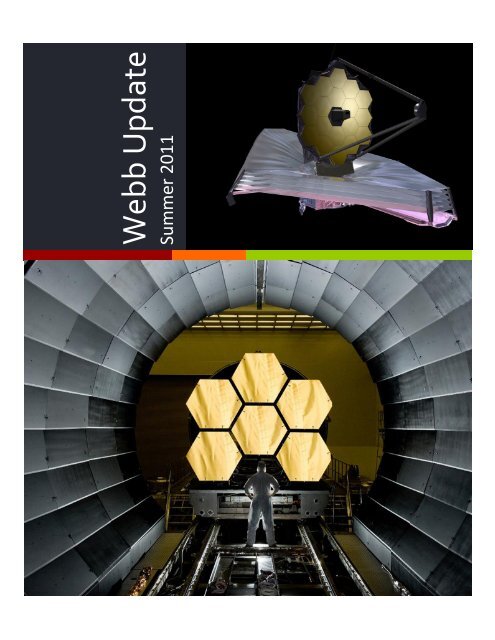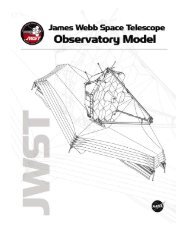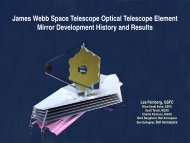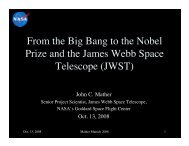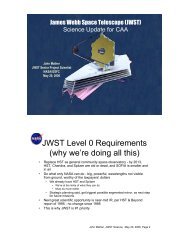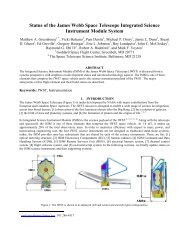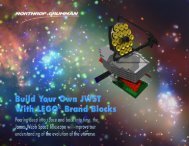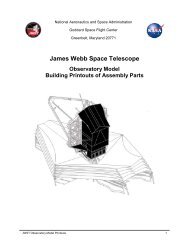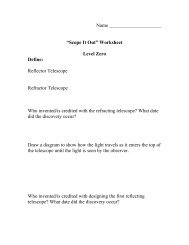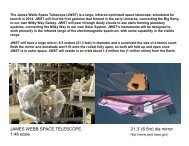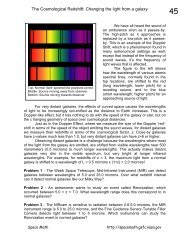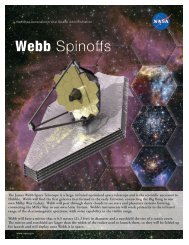Download the .pdf - James Webb Space Telescope - NASA
Download the .pdf - James Webb Space Telescope - NASA
Download the .pdf - James Webb Space Telescope - NASA
You also want an ePaper? Increase the reach of your titles
YUMPU automatically turns print PDFs into web optimized ePapers that Google loves.
<strong>Webb</strong> Update <br />
Summer 2011 <br />
Suspendisse lobortis, quam <br />
ac euismod sodales, diam <br />
turpis luctus nunc, vel <br />
porta mauris enim quis <br />
ipsum. <br />
Maecenas in quam. <br />
Mauris libero massa, <br />
fringilla nec, dictum eget, <br />
tempus a, odio. Aliquam <br />
lorem. <br />
In lacinia, enim sed luctus <br />
ultricies, velit odio tempor <br />
mauris, in aliquet nunc sem <br />
tempor nisi. Vestibulum <br />
sodales.
MIRI Testing <br />
Almost <br />
Finished <br />
by Gillian Wright & <br />
George Rieke <br />
One of <strong>the</strong> four instruments for <br />
JWST is MIRI, <strong>the</strong> Mid-‐InfraRed <br />
Instrument. MIRI contains a <br />
camera and a medium resolution <br />
integral field spectrograph, both of <br />
which cover <strong>the</strong> wavelength range <br />
of 5 to 28 microns (plus <br />
coronagraphs and a low resolution <br />
spectrometer operating over more <br />
restricted spectral ranges). The <br />
long wavelength range means that <br />
MIRI is unique among <strong>the</strong> JWST <br />
instruments because it has to be <br />
cooled to 7K, which also brings <br />
challenges for testing <strong>the</strong> <br />
instrument. <br />
The construction of <strong>the</strong> flight <br />
instrument is complete and it has <br />
nearly finished its environmental <br />
and cryogenic performance tests at <br />
<strong>the</strong> Ru<strong>the</strong>rford Appleton <br />
Laboratory in England. To test MIRI <br />
thoroughly a special test chamber <br />
was constructed that cools <strong>the</strong> <br />
instrument to its 7K operating <br />
temperature inside shrouds that <br />
represent <strong>the</strong> 40K environment <br />
and background that <strong>the</strong> <br />
instrument will see in operation on <br />
JWST. A telescope simulator <br />
provides both point sources and <br />
extended illumination so that <strong>the</strong> <br />
testing can exercise thoroughly all <br />
<strong>the</strong> different modes of <strong>the</strong> <br />
instrument. An international team <br />
of about 30 people from <br />
11 countries is working <br />
24 hours a day, seven <br />
days a week to complete <br />
<strong>the</strong> testing. The <br />
campaign is progressing <br />
extremely well, and <strong>the</strong> <br />
images and spectra <br />
indicate that <strong>the</strong> <br />
scientific performance of <br />
<strong>the</strong> instrument is as predicted from <br />
modeling and analyses, which is <br />
good news for JWST science. MIRI <br />
completed <strong>the</strong> cryogenic portion of <br />
its testing on August 3, 2011. This <br />
will be followed by warm <br />
alignment measurements of <strong>the</strong> <br />
precise position of optical <br />
references on MIRI with respect to <br />
<strong>the</strong> JWST alignment fiducials, <br />
followed by preparations for <strong>the</strong> <br />
acceptance review and instrument <br />
delivery. <br />
Above: MIRI cryogenic test first light images (credit: Mike Ressler, RAL, & <strong>the</strong> <br />
MIRI team). Right: MIRI instrument outside <strong>the</strong> test chamber (credit: RAL, <strong>the</strong> <br />
MIRI European Consortium, & JPL). <br />
<br />
2
ISIM Structure Completes Integration <br />
and Testing <br />
By Eric Johnson <br />
Above: ISIM Structure (inside a protective bag to maintain cleanliness) mounted on <strong>the</strong> Goddard HCC and ready for <br />
one of seven acceleration tests. Left inset: cooldown distortions from ambient to 39K over <strong>the</strong> >2m Structure are less <br />
than <strong>the</strong> width of a pencil lead. <br />
The ISIM Optical Metering Structure (Structure) is a state-‐of-<strong>the</strong>-‐art<br />
bonded composite structure which houses <strong>the</strong> JWST <br />
Science Instruments. The Structure holds <strong>the</strong> instruments in <br />
<strong>the</strong> correct position with respect to each o<strong>the</strong>r and <strong>the</strong> Optical <br />
<strong>Telescope</strong> Element through launch and <strong>the</strong>n through >250 <br />
degrees C of temperature swing to operating temperature. It is <br />
JWST’s first large composite cryogenic structure to be built and <br />
tested. The Structure has been through several qualification <br />
tests to assure performance prior to installation of <strong>the</strong> flight <br />
Science Instruments. The qualification tests are: <br />
<br />
1) The cryo-‐distortion test completed in May 2010 that <br />
measured cool-‐down distortions and showed that <br />
distortions are well within <strong>the</strong> 0.5 mm limits (<strong>the</strong> <br />
width of a pencil lead), <br />
2) The cryo proof test that completed in October 2010 <br />
that demonstrated that <strong>the</strong> Structure will safely <br />
support <strong>the</strong> instruments during ISIM cryogenic <br />
performance testing, <br />
3) The modal survey test completed in March 2011 that <br />
characterized <strong>the</strong> ambient dynamic behavior of <strong>the</strong> <br />
Structure needed to correlate <strong>the</strong> Structure Finite <br />
Element Model, and <br />
4) The ambient proof testing completed in June 2011 <br />
that demonstrated that <strong>the</strong> primary Structure will <br />
survive launch. <br />
Proof testing was accomplished using <strong>the</strong> High Capacity <br />
Centrifuge (HCC), which applied a series of centripetal <br />
acceleration fields that acted on <strong>the</strong> Structure and <strong>the</strong> Science <br />
Instruments mass simulators to generate forces that simulated <br />
<strong>the</strong> loads that will be experienced when JWST launches on <strong>the</strong> <br />
Arianne V rocket. The effect is <strong>the</strong> same as that experienced by <br />
children riding a spinning merry-‐go-‐round, but many times <br />
larger. During HCC testing, <strong>the</strong> arm rotated at speeds up to <br />
nearly 19 rpm, creating acceleration fields of up to 7 times <strong>the</strong> <br />
acceleration of gravity that were applied to <strong>the</strong> Structure and <br />
mass simulators. This resulted in 7 tons of net force at <strong>the</strong> <br />
attachment points to <strong>the</strong> telescope. Testing was successful, <br />
and <strong>the</strong> Structure is now back in <strong>the</strong> Goddard cleanroom being <br />
prepared for final checkouts prior to delivery to ISIM <br />
Integration and Test. <br />
3
JWST Mirrors Cross Major Milestone <br />
by Mark Clampin <br />
The <strong>James</strong> <strong>Webb</strong> <strong>Space</strong> <strong>Telescope</strong> (JWST) project has just recently completed polishing all of <strong>the</strong> mirrors that make up <strong>the</strong> <br />
telescope, a major milestone for <strong>the</strong> project. Driven by its goal of finding <strong>the</strong> first galaxies that appeared in <strong>the</strong> universe, <br />
JWST has a three-‐mirror anastigmat optical design, tailored for wide-‐field imaging. Due to its size, JWST has to deploy from a <br />
stowed configuration after launch and so <strong>the</strong> primary mirror is built from 18 hexagonal segments permitting <strong>the</strong> primary <br />
mirror to be folded for launch. The 6.5 meter diameter of <strong>the</strong> 18 segment primary mirror produces a diffraction-‐limited image <br />
at 2 microns. In order to maintain diffraction-‐limited performance a fourth telescope mirror is employed to correct for image <br />
jitter, <strong>the</strong> fine steering mirror. Figure 1 shows each of <strong>the</strong> four mirror types that comprise <strong>the</strong> telescope optical chain. <br />
Each of <strong>the</strong> 21 mirrors in JWST’s optical chain is made of beryllium. Beryllium was selected for its stability at cryogenic <br />
temperatures combined with its stiffness and relatively light-‐weight. Beryllium mirrors are much more difficult to polish than <br />
glass, and so <strong>the</strong> mirror fabrication and polishing phase of <strong>the</strong> JWST program was initially identified as <strong>the</strong> longest lead item <br />
on <strong>the</strong> program. Thus, with <strong>the</strong> completion of <strong>the</strong> last two mirror segments at Tinsley, <strong>the</strong> JWST project has completed its <br />
longest lead milestone. The resulting composite surface wavefront error of <strong>the</strong> 18 segment primary mirror meets <strong>the</strong> 17 nm <br />
requirement allocated for this element of <strong>the</strong> telescope with adequate margin. <br />
While polishing of <strong>the</strong> mirrors is complete, <strong>the</strong>re are still many steps to complete construction of <strong>the</strong> JWST telescope. The <br />
primary mirror segments have to be coated with a thin layer of gold for optimum infrared reflectivity (15 of 18 segments have <br />
been coated at <strong>the</strong> time of publication), and <strong>the</strong>n assembled into a mirror assembly which requires <strong>the</strong> installation of <strong>the</strong> <br />
seven actuators that provide both six degree of freedom authority for <strong>the</strong> mirrors, combined with a radius of curvature <br />
adjustment. The primary mirror segments <strong>the</strong>n undergo a 3-‐axis sine-‐vibration test (12 of 18 segments have passed <strong>the</strong>ir <br />
vibration test at <strong>the</strong> time of publication) to demonstrate <strong>the</strong>y can survive launch in <strong>the</strong> Ariane 5, followed by an cryogenic <br />
optical test at 40 K to verify <strong>the</strong>y meet <strong>the</strong>ir optical specification. The first six flight mirrors to undergo <strong>the</strong>ir cryogenic optical <br />
acceptance test are shown in Figure 2 as <strong>the</strong>y are rolled into <strong>the</strong> X-‐Ray calibration facility at <strong>the</strong> Marshall <strong>Space</strong> Flight Center. <br />
The second set of six mirrors went into <strong>the</strong> <strong>the</strong>rmal vacuum chamber on July 29. <br />
<br />
4
Scientists Ga<strong>the</strong>r <br />
for JWST <br />
Frontiers <br />
Workshop <br />
by Jason Kalirai <br />
The <strong>Space</strong> <strong>Telescope</strong> <br />
Science Institute in <br />
Baltimore, MD hosted <strong>the</strong> <br />
“Frontier Science <br />
Opportunities with JWST” <br />
meeting on June 6-‐8th, <br />
2011. The meeting brought <br />
toge<strong>the</strong>r nearly 200 <br />
astronomers from around <br />
<strong>the</strong> world, including many <br />
students and postdoctoral <br />
researchers, to engage one <br />
ano<strong>the</strong>r in <strong>the</strong> science <br />
potential of JWST. The 3 <br />
day meeting contained over <br />
20 talks, dedicated poster <br />
sessions and presentations, <br />
and over 1/3 of <strong>the</strong> total <br />
time devoted to discussion. <br />
(Continued) <br />
The science presented at <strong>the</strong> <br />
Frontiers meeting amplified <br />
<strong>the</strong> unique role that JWST will <br />
play in <strong>the</strong> future of <br />
astronomy. Speakers <br />
discussed how <strong>the</strong> multiple <br />
imaging, spectroscopic, and <br />
coronagraphic modes would <br />
enable new breakthroughs in <br />
astrophysical topics ranging <br />
from characterizing Solar <br />
System planets and Kuiper Belt <br />
Objects, to searching for <strong>the</strong> <br />
first cosmic explosions in <strong>the</strong> <br />
Universe. Several speakers <br />
also took advantage of <strong>the</strong> <br />
newly released JWST Prototype <br />
Exposure Time Calculators to <br />
establish a reasonable <br />
feasibility of <strong>the</strong>ir science <br />
programs. In addition to <br />
streng<strong>the</strong>ning <strong>the</strong> core science <br />
<strong>the</strong>mes of JWST, speakers <br />
revealed new possibilities to <br />
improve our understanding of <br />
fundamental stellar relations <br />
such as <strong>the</strong> initial mass <br />
function, <strong>the</strong> hydrogen burning <br />
limit, <strong>the</strong> star formation law, <br />
and feedback on both stellar <br />
and galactic scales. JWST <br />
studies of <strong>the</strong> flatness of <strong>the</strong> <br />
Universe through high <br />
precision (~1% accuracy) <br />
measurements of <strong>the</strong> Hubble <br />
constant will also impact dark <br />
energy research in <strong>the</strong> future. <br />
All of <strong>the</strong> presentations and <br />
slides from <strong>the</strong> "Frontier <br />
Science Opportunities with <br />
JWST" meeting can be <br />
downloaded from <br />
http://webcast.stsci.edu/webcast/ <br />
and interested scientists are <br />
encouraged to explore <strong>the</strong> <br />
newly released JWST Exposure <br />
Time Calculators at <br />
http://jwstetc.stsci.edu/etc/. <br />
<br />
5
Would you like a colloquium <br />
at your university on JWST? <br />
How about a talk at a <br />
conference you are <br />
organizing? These JWST <br />
scientists are willing to give <br />
a talk. All expenses will be <br />
paid by <strong>the</strong> JWST project for <br />
talks in <strong>the</strong> US; talks in o<strong>the</strong>r <br />
countries can also be <br />
arranged. <br />
To arrange a talk, please email <br />
contactswg@jwst.nasa.gov or contact <br />
<strong>the</strong> speaker directly. <br />
For European universities and institutions <br />
interested in inviting speakers to give <br />
talks covering <strong>the</strong> full range of scientific <br />
topics addressed by JWST, please contact <br />
Peter Jakobsen (ESA JWST Project <br />
Scientist, ESTEC, pjakobse@rssd.esa.int). <br />
• Mark Clampin, GSFC, "Exoplanets with JWST" <br />
• Rene Doyon, Universite de Montreal, "JWST Tunable Filter <br />
Science" <br />
• Jonathan Gardner, GSFC, "JWST and Galaxy Evolution" <br />
• Matt Greenhouse, GSFC, "JWST Mission Overview and <br />
Status" <br />
• Heidi Hammel, AURA, "Planetary Exploration with JWST" <br />
• John Hutchings, DAO, "JWST’s Guider and Tunable Filter <br />
Imager" <br />
• Jonathan Lunine, Cornell University, "JWST, Exoplanets and <br />
<strong>the</strong> Solar System" <br />
• John Ma<strong>the</strong>r, GSFC, "JWST Mission Overview and Status" <br />
• Bernie Rauscher, GSFC, “JWST and it's HAWAII-‐2RG and <br />
SIDECAR ASIC Detector Systems” <br />
• George Rieke, University of Arizona, "Debris Disks and <strong>the</strong> <br />
Evolution of Planetary Systems" or “The Place of JWST in <br />
<strong>the</strong> growth of Infrared Astronomy” <br />
• Marcia Rieke, University of Arizona, "NIRCam for JWST: <br />
Exoplanets to Deep Surveys" <br />
• Jane Rigby, GSFC, “Gravitationally Lensed Galaxies and <br />
JWST” or “AGN and JWST” <br />
• George Sonneborn, GSFC, "Imaging and Spectroscopy with <br />
JWST" <br />
• Massimo Stiavelli, STScI, "Studying <strong>the</strong> first galaxies and <br />
reionization with JWST" <br />
• Amber Straughn, GSFC, “JWST and Galaxy Assembly” <br />
• Rogier Windhorst, Arizona State University, "JWST and <br />
Reionization" or "JWST and Supermassive Black Hole <br />
Growth” <br />
<br />
The speakers are also available to give <br />
JWST Mission Overview talks and talks at <br />
<strong>the</strong> general public level. <br />
<strong>Webb</strong> Update Summer 2011 <br />
Amber Straughn, Editor <br />
6


